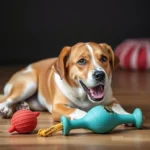
Introduction
Every pet parent knows that a happy dog is a stimulated dog. Just like humans, dogs need mental challenges to keep their minds sharp and engaged. This is where DIY dog puzzles come into play. Not only do these puzzles provide an excellent outlet for your furry friend’s energy, but they also promote mental stimulation, which is crucial for their overall well-being.
Engaging in DIY activities with your pet can be incredibly rewarding. It allows you to bond with your dog while creating something unique to their needs and preferences. Plus, making your own dog puzzles can be more fulfilling than purchasing pre-made ones, as you can tailor them specifically to your dog’s interests and abilities.
Understanding Dog Behavior and Mental Stimulation
The Importance of Mental Stimulation
Mental stimulation for dogs refers to activities that challenge their brains and encourage them to think. It can include anything from basic obedience training to complex puzzle games. Engaging your dog’s mind can lead to improved behavior and emotional stability. Dogs that receive adequate mental stimulation tend to be less anxious, less aggressive, and less prone to destructive behaviors.
Common Signs of Boredom in Dogs
Just like humans, dogs can exhibit signs of boredom. Here are some behaviors that indicate your dog may be feeling under-stimulated:
- Excessive barking: If your dog is barking more than usual, it could be a sign of boredom.
- Destructive chewing: Dogs often chew on furniture or personal items when they lack mental engagement.
- Restlessness: Pacing or an inability to settle down can indicate that your dog needs more stimulation.
- Lethargy: On the flip side, some dogs may become lethargic when they aren’t mentally engaged.
Benefits of DIY Dog Puzzles
Creating your own DIY dog puzzles comes with a variety of benefits:
- Cost-effectiveness: Making puzzles at home can save you money compared to buying expensive toys.
- Customization: You can design puzzles that cater specifically to your dog’s preferences and skill levels.
- Strengthening the human-animal bond: Working together on DIY projects can enhance your connection with your dog.
Types of DIY Dog Puzzles
Basic Puzzle Concepts
When we talk about dog puzzles, we refer to activities that challenge your dog’s cognitive skills. These puzzles can range from simple treat-hiding games to more complex interactive toys. Here’s an overview of different puzzle types you can create:
- Interactive puzzles: These require your dog to move pieces or manipulate objects to find treats.
- Hiding treats: These puzzles involve concealing treats within other materials, prompting your dog to sniff and dig them out.
Simple DIY Puzzle Ideas
Towel Roll-Up Puzzle
This simple and engaging puzzle can be made with just a few materials.
Materials needed:
– A large towel
– Your dog’s favorite treats
Step-by-step instructions:
1. Lay the towel flat on a surface.
2. Sprinkle treats across the towel.
3. Roll up the towel tightly, making sure treats are hidden inside.
4. Allow your dog to unroll the towel to find the treats.
Tips for success:
– Start with a few treats to make it easier for your dog, then gradually increase the number.
– Supervise your dog to ensure they don’t chew the towel.
Muffin Tin Challenge
This challenge uses a muffin tin to hide treats and has your dog working to uncover them.
Materials needed:
– A muffin tin
– Tennis balls or similar-sized balls
– Treats
Step-by-step instructions:
1. Place treats in some of the muffin tin holes.
2. Cover all the holes with tennis balls.
3. Present the muffin tin to your dog and let them figure out how to get to the treats.
Tips for success:
– Use different sizes of treats to keep your dog intrigued.
– Start without the balls to help your dog understand the game.
Bottle Toss Game
This fun game encourages your dog to engage in play and problem-solving.
Materials needed:
– A few empty plastic bottles
– Treats
Step-by-step instructions:
1. Remove the label from the bottles and ensure they are clean.
2. Place treats inside the bottles.
3. Allow your dog to figure out how to get the treats out by tossing or rolling the bottles.
Tips for success:
– Supervise your dog to make sure they don’t ingest any plastic.
– Start with larger openings to make it easier at first.
Advanced Puzzle Ideas
Interactive Tug Toy
If your dog enjoys tugging, this puzzle will provide both mental and physical engagement.
Materials needed:
– A sturdy rope or fabric strips
– Treats
Step-by-step instructions:
1. Braid the rope or fabric strips together to create a tug toy.
2. Hide treats within the braids.
3. Encourage your dog to tug and pull to uncover the treats.
Tips for success:
– Ensure that the materials are durable and safe for your dog.
– Monitor playtime to prevent any excessive force that could cause injury.
Puzzle Box Challenge
This advanced puzzle requires your dog to figure out how to open a box to get to the treats inside.
Materials needed:
– A cardboard box
– Treats
– Scissors (for cutting holes)
Step-by-step instructions:
1. Cut holes in the box that are large enough for your dog to reach in.
2. Place treats inside the box.
3. Close the box and let your dog figure out how to get the treats out.
Tips for success:
– Use a sturdy box that can withstand some excitement.
– Encourage your dog and guide them if they seem frustrated.
Safety Considerations
Choosing Safe Materials
When creating DIY dog puzzles, it’s essential to choose safe materials. Here are some guidelines:
- Safe materials: Cardboard, fabric, sturdy plastic, and rope.
- Unsafe materials: Small items that could be swallowed, toxic substances, or anything that can easily break into sharp pieces.
Supervision and Monitoring
Always supervise your dog during playtime, especially with new puzzles. Watch for signs of frustration or danger, such as:
- Chewing on inappropriate parts of the puzzle.
- Signs of stress or anxiety.
- Inability to solve the puzzle after a reasonable amount of time.
Making the Most of Your DIY Dog Puzzles
Tailoring Puzzles to Your Dog’s Needs
To keep your dog engaged, it’s crucial to tailor puzzles according to their skill level and preferences. Observe how your dog interacts with different puzzles and adjust the difficulty as needed. You want to ensure the challenge is stimulating but not too frustrating.
Rotating Puzzles for Continuous Interest
Dogs thrive on variety. Rotate your DIY dog puzzles regularly to keep their interest piqued. By introducing new puzzles and swapping out old ones, you can maintain a high level of engagement.
Incorporating Training into Puzzle Play
Use puzzles as a training tool by incorporating commands and cues during play. Encourage your dog to sit or stay before allowing them to interact with the puzzle. This not only reinforces training but also enhances problem-solving skills and patience.
Conclusion
Creating DIY dog puzzles is an excellent way to provide your furry friend with the mental stimulation they need. Not only do you save money and customize their play, but you also strengthen your bond through shared activities. So grab some materials and start crafting puzzles that will keep your dog engaged and entertained.
Encourage your furry friend’s curiosity and cleverness by diving into the fun world of DIY dog puzzles today!









